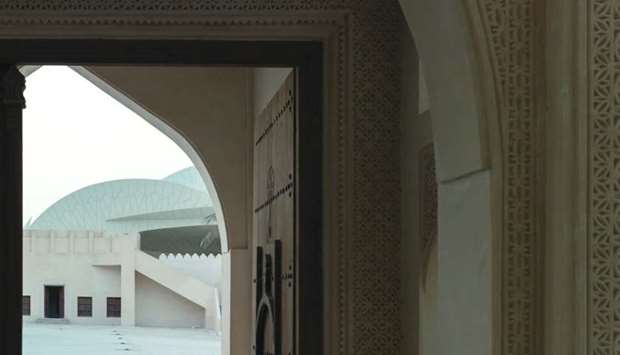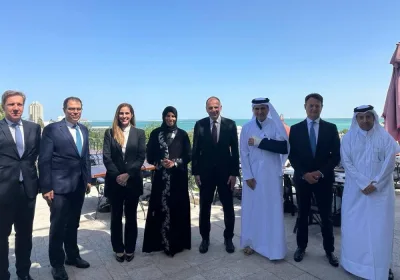Featuring 11 interlinked galleries, the National Museum of Qatar (NMoQ) will showcase an impressive array of archaeological and heritage objects, including the renowned ‘Pearl Carpet of Baroda’, during its official opening on March 28, 2019, Qatar Museums (QM) has announced.
“The National Museum is special: it tells an immense, sweeping story in a way that is richly layered, immersive, and experiential,” NMoQ director Sheikha Amna bint Abdulaziz al-Thani told a press briefing on Monday at IDAM restaurant at the Museum of Islamic Art.
Sheikha Amna, along with senior QM officials, was giving a glimpse into what was described as “the visitor-focused experience” NMoQ was designed to create.
The event was attended by NMoQ representatives and senior QM officials, including Mansoor bin Ebrahim al-Mahmoud, special adviser to chairperson HE Sheikha Al Mayassa bint Hamad bin Khalifa al-Thani; Dr Karen Exell, NMoQ senior museum development specialist; Dr Haya al-Thani, NMoQ deputy director of Curatorial Affairs; and Saif al-Kuwari, NMoQ deputy director of operations.
Qatar’s stunning museum, housed within a new building designed by renowned French architect Jean Nouvel, is set to be inaugurated next year, under the patronage of His Highness the Amir Sheikh Tamim bin Hamad bin Khalifa al-Thani.
“Our ambition is to invite our visitors to participate in a journey: an actual, physical passage through the museum, which unfolds along a route that is almost 1.5km long,” Sheikha Amna said.
The visitor’s chronological journey, she noted, will begin in the geological period long before the peninsula was inhabited by humans and continues to the present day.
“Each gallery will have its own special approach. And the galleries are so rich and multi-layered that there will always be more for you to experience and explore, no matter how often you visit,” Sheikha Amna added.
The new museum will also display the ‘Pearl Carpet of Baroda’ – known as an embroidered masterpiece with more than 1.5mn of the highest quality Gulf pearls and adorned with emeralds, diamonds, and sapphires—as well as manuscripts, documents, photographs, jewellery, and costumes.
“The National Museum will give visitors an unprecedented museum experience, with people at the heart of its vision and development,” the NMoQ director stressed. “Jean Nouvel’s dynamic architectural design echoes the geography of Qatar while evoking the history and culture of the nation.”
QM describes each gallery as “an all-encompassing environment,” which tells its part of the grand story through a creative combination of elements such as music, storytelling, archival images, oral histories and evocative aromas.
Local and international artists have been invited to create site-specific commissions, in response to the museum’s collection and as an enhancement of the exhibition experience.
Working with expert craftspeople from around the globe, Dr Exell said they created over 1,400 beautiful bespoke models for the museum: natural history, architectural, archaeological, document replicas, boat models, tactile models and models for children.
“We have over 150 extraordinary digital media productions embedded within the exhibits, contributing to the immersive and multi-layered experience. The productions were led by a local team and created by international digital creative,” she noted. “The artworks commissioned for the National Museum are equally integral to the experience.”
“I cannot think of a more moving and expressive way to show that NMoQ is the past fused with the present and future — a deeply rooted, immemorial culture and heritage joined with an exciting, contemporary, global experience,” Dr Exell added. “I am truly excited at the prospect of seeing all this come alive for the public in March.”
About data related to oral histories that feature heavily in the Museum, Dr Haya said they also worked with partners, including the Doha Film Institute, for more than five years to record these memories and preserve information about the country.
More than 70 films will be displayed through the museum galleries, bringing the displays of objects to life through shared memories of recent history. In all, more than 300 members of the public participated in the project.
Sheikha Amna, along with senior QM officials, was giving a glimpse into what was described as “the visitor-focused experience” NMoQ was designed to create.
The event was attended by NMoQ representatives and senior QM officials, including Mansoor bin Ebrahim al-Mahmoud, special adviser to chairperson HE Sheikha Al Mayassa bint Hamad bin Khalifa al-Thani; Dr Karen Exell, NMoQ senior museum development specialist; Dr Haya al-Thani, NMoQ deputy director of Curatorial Affairs; and Saif al-Kuwari, NMoQ deputy director of operations.
Qatar’s stunning museum, housed within a new building designed by renowned French architect Jean Nouvel, is set to be inaugurated next year, under the patronage of His Highness the Amir Sheikh Tamim bin Hamad bin Khalifa al-Thani.
“Our ambition is to invite our visitors to participate in a journey: an actual, physical passage through the museum, which unfolds along a route that is almost 1.5km long,” Sheikha Amna said.
The visitor’s chronological journey, she noted, will begin in the geological period long before the peninsula was inhabited by humans and continues to the present day.
“Each gallery will have its own special approach. And the galleries are so rich and multi-layered that there will always be more for you to experience and explore, no matter how often you visit,” Sheikha Amna added.
The new museum will also display the ‘Pearl Carpet of Baroda’ – known as an embroidered masterpiece with more than 1.5mn of the highest quality Gulf pearls and adorned with emeralds, diamonds, and sapphires—as well as manuscripts, documents, photographs, jewellery, and costumes.
“The National Museum will give visitors an unprecedented museum experience, with people at the heart of its vision and development,” the NMoQ director stressed. “Jean Nouvel’s dynamic architectural design echoes the geography of Qatar while evoking the history and culture of the nation.”
QM describes each gallery as “an all-encompassing environment,” which tells its part of the grand story through a creative combination of elements such as music, storytelling, archival images, oral histories and evocative aromas.
Local and international artists have been invited to create site-specific commissions, in response to the museum’s collection and as an enhancement of the exhibition experience.
Working with expert craftspeople from around the globe, Dr Exell said they created over 1,400 beautiful bespoke models for the museum: natural history, architectural, archaeological, document replicas, boat models, tactile models and models for children.
“We have over 150 extraordinary digital media productions embedded within the exhibits, contributing to the immersive and multi-layered experience. The productions were led by a local team and created by international digital creative,” she noted. “The artworks commissioned for the National Museum are equally integral to the experience.”
“I cannot think of a more moving and expressive way to show that NMoQ is the past fused with the present and future — a deeply rooted, immemorial culture and heritage joined with an exciting, contemporary, global experience,” Dr Exell added. “I am truly excited at the prospect of seeing all this come alive for the public in March.”
About data related to oral histories that feature heavily in the Museum, Dr Haya said they also worked with partners, including the Doha Film Institute, for more than five years to record these memories and preserve information about the country.
More than 70 films will be displayed through the museum galleries, bringing the displays of objects to life through shared memories of recent history. In all, more than 300 members of the public participated in the project.




